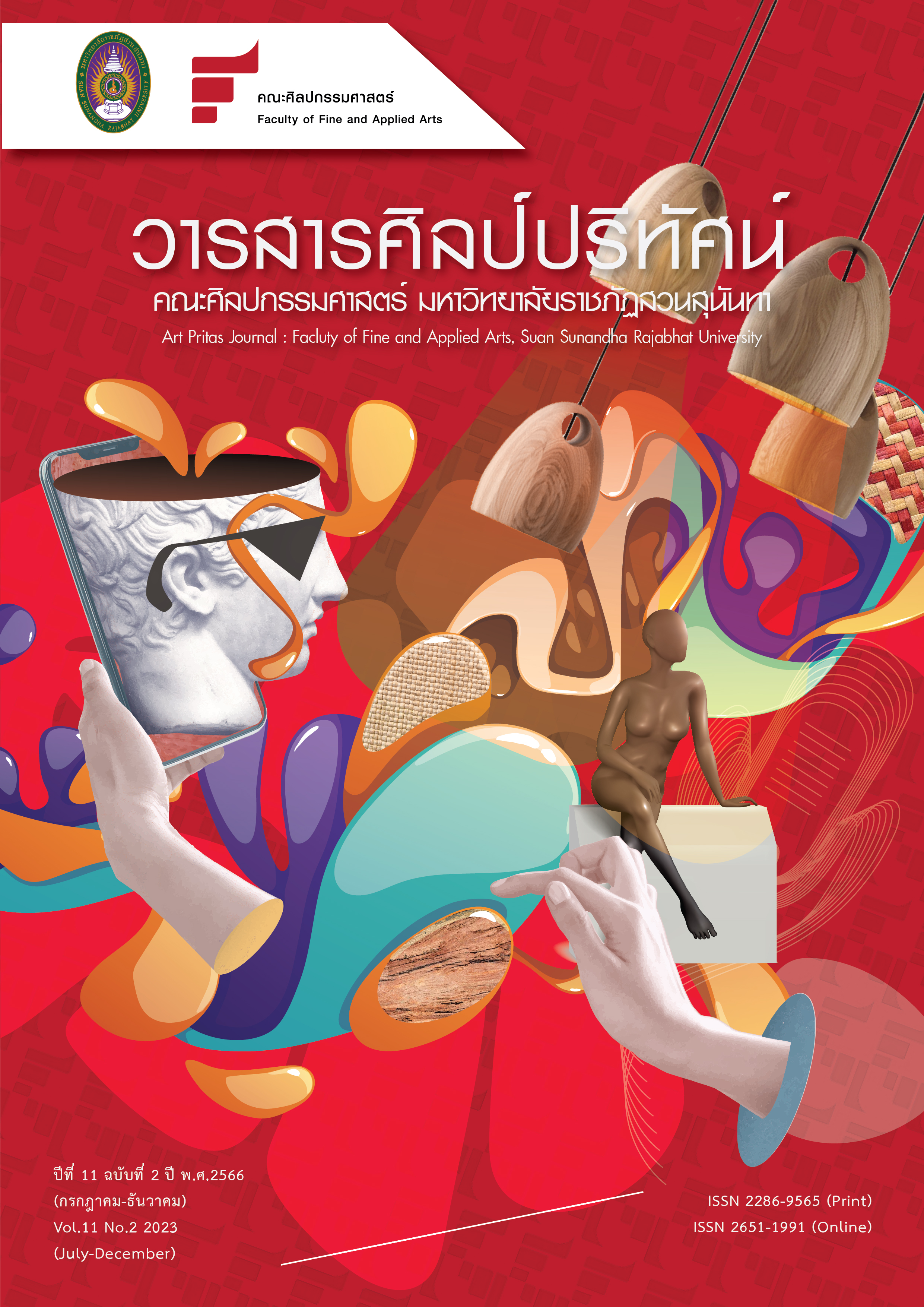กระบวนท่ารำซัดเลือกคู่ในละครเรื่องมโนห์รา ตอนพระสุธนเลือกคู่ หลักสูตรศึกษาศาสตรบัณฑิต สาขาวิชานาฏศิลปศึกษา สถาบันบัณฑิตพัฒนศิลป์
Main Article Content
บทคัดย่อ
งานวิจัยฉบับนี้มีวัตถุประสงค์เพื่อ 1.ศึกษาความเป็นมา และองค์ประกอบละครเรื่องมโนห์รา ตอนพระสุธนเลือกคู่ 2.วิเคราะห์กระบวนท่ารำซัดเลือกคู่ ในละครเรื่องมโนห์รา ตอนพรพระสุธนเลือกคู่ที่ปรากฎในหลักสูตรศึกษาศาสตรบัณฑิต สาขาวิชานาฏศิลปศึกษา สถาบันบัณฑิตพัฒนศิลป์ โดยได้รับการถ่ายทอดกระบวนท่ารำซัดเลือกคู่ ในละครเรื่องมโนห์รา ตอนพระสุธนเลือกคู่ ได้แก่ ละครนาง คือคุณครูนพรัตน์ศุภาการ หวังในธรรม ผู้เชี่ยวชาญนาฏศิลป์ไทย และละครพระ คือ คุณครูเวณิกา บุนนาค ศิลปินแห่งชาติ
ผลการศึกษาพบว่า ละครเรื่องมโนห์รา ตอนพระสุธนเลือกคู่ อยู่ในฉากที่ 5 ได้แต่งบทละครขึ้นใหม่ และนำเอาศิลปะแห่งนาฏกรรมมาผสมกันแล้วปรับปรุงขึ้นใหม่ ได้แก่ ละครโนห์ราชาตรี และละครนอก แต่ก็คงรักษาแนวทางละครชาตรีของเดิมไว้ เช่น เครื่องดนตรีก็ใช้เครื่องปี่พาทย์อย่างที่ใช้ประกอบละครชาตรีแต่เดิมผสมอยู่ด้วย คือ วงปี่พาทย์ไม้นวม และเครื่องดนตรีชาตรี คือปี่ชวา โทน และกลองชาตรี ส่วนเพลงที่ใช้ประกอบละครรำ คือเพลงเวสสุกรรม เพลงประกอบละครโนราชาตรี คือ เพลงร่ายชาตรี เพลงรำซัด และเพลงชาตรีตลุง การแต่งกายแบบละครรำ มีการพัฒนาศิราภรณ์อันเป็นเอกลักษณ์การแต่งกายของละคร เรื่องมโนห์รา คือ สวมเทริดพระ-เทริดนาง แต่งกายยืนเครื่องพระ-นาง
จากการวิเคราะห์กระบวนท่ารำซัดเลือกคู่ ในละครเรื่องมโนห์รา ตอนพระสุธนเลือกคู่ที่ปรากฎในหลักสูตรศึกษาศาสตรบัณฑิต สาขาวิชานาฏศิลปศึกษา สถาบันบัณฑิตพัฒนศิลป์ ปีพ.ศ. 2542 ผู้วิจัยพบว่า มีท่าหลักที่สำคัญในการเลือกคู่ ได้รับอิทธิพลมาจากการแสดงละครชาตรี ผู้ถ่ายทอดท่ากระบวนท่ารำซัด คือ คุณครูมัลลี คงประภัศร์ ผู้เคยแสดงละครชาตรีมาก่อน กับคุณครูลมุล ยมะคุปต์ ผู้ปรับปรุงและประดิษฐ์ออกแบบกระบวนท่ารำ ซึ่งการซัดท่าเลือกคู่จะเน้นการรำให้ลงจังหวะโทนชาตรี คือ จังหวะ ป๊ะ โทนโทน ป๊ะโทน โทนป๊ะ นับเป็น 1 จังหวะ
กระบวนท่าหลักที่ปรากฎในการรำซัดเลือกคู่ ประกอบด้วย 1)แม่ท่ารำละครโนห์รา จำนวน 3 ท่า 2)แม่ท่ารำซัดชาตรี จำนวน 4 ท่า 3)ท่ารำแม่บทใหญ่ จำนวน 2 ท่า
กระบวนท่าเชื่อมในเพลงรำซัดของนางกินรีทั้ง 7 มีลักษณะการเชื่อมท่าเหมือนกับท่ารำในเพลงมาตรฐาน จำนวน 4 เพลง ประกอบด้วย 1)เพลงแม่บทใหญ่ จำนวน 4 ท่า 2)เพลงแม่บทเล็ก จำนวน 1 ท่า 3)เพลงช้า จำนวน 2 ท่า 4)เพลงเร็ว จำนวน 2 ท่า
กระบวนท่ารำซัด แบ่งออกเป็น 3 ลักษณะ ดังนี้
1.กระบวนท่ารำซัดเลือกคู่ที่มีลักษณะการรำเดี่ยว
2.กระบวนท่ารำซัดเลือกคู๋ที่มีลักษณะการรำเข้าคู่
3.กระบวนท่ารำซัดเลือกคู่ที่มีลักษณะการรำเป็นหมู่
การแปรแถวของกระบวนท่าซัดเลือกคู่ มี 3 แบบ คือ 1)การแปรแถวปากพนัง 2)การแปรแถวครึ่งวงกลม และ 3)การแปรแถววงกลม มีการเคลื่อนที่ของแถวไปมาตามการเข้าออกของนางกินรีที่ไปรำซัดคู่ และการเคลื่อนแถวในรูปวงกลม จัดให้พระสุธนรำอยู่ตรงกลางเพื่อเลือกคู่หานางมโนห์รา
Article Details

อนุญาตภายใต้เงื่อนไข Creative Commons Attribution-NonCommercial-NoDerivatives 4.0 International License.
เนื้อหาและข้อมูลในบทความที่ลงตีพิมพ์ในวารสารศิลป์ปริทัศน์ ถือเป็นข้อคิดเห็นและความรับผิดชอบของผู้เขียนบทความโดยตรง ซึ่งกองบรรณาธิการวารสารไม่จำเป็นต้องเห็นด้วย หรือร่วมรับผิดชอบใดๆ
บทความ ข้อมูล เนื้อหา รูปภาพ ฯลฯ ที่ได้รับการตีพิมพ์ในวารสารศิลป์ปริทัศน์ถือเป็นลิขสิทธิ์ของวารสารศิลป์ปริทัศน์
เอกสารอ้างอิง
กรมศิลปากร. (2542). วิพิธทัศนา. กรุงเทพฯ: สถาบันนาฏดุริยางคศิลป์.
กระทรวงศึกษาธิการ. (2537). หลักสูตรนาฏศิลป์ชั้นสูง พุทธศักราช 2527 (พิมพ์ครั้งที่ 2). กรุงเทพฯ: ประชาชน.
ธนิต อยู่โพธิ์. (2531). ศิลปะละครรำหรือคู่มือนาฏศิลป์ไทย (พิมพ์ครั้งที่ 2). กรุงเทพฯ: ศิลปากร.
ไพโรจน์ ทองคำสุก. (2545). วิเคราะห์รูปแบบความเป็นครูสู่กระบวนการถ่ายทอดความรู้ของผู้เชี่ยวชาญนาฏศิลป์ไทย ครูเฉลย
ศุขะวณิช. กรุงเทพฯ: สถาบันนาฏดุริยางคศิลป์ กรมศิลปากร.
เรณู โกศินานนท์. (2543). นาฏศิลป์ไทย. กรุงเทพฯ: ไทยวัฒนาพานิชย์.
วินัย ภู่ระหงษ์. (2520). พระสุธน-มโนห์รา:การศึกษาเปรียบเทียบที่มาและความสัมพันธ์ระหว่างฉบับต่างๆ. (วิทยานิพนธ์ปริญญาโท)
จุฬาลงกรณ์มหาวิทยาลัย Chulalongkorn University Intellectual Repository (CUIR). สืบค้นจากhttp://cuir.car.chula.ac.th/handle/123456789/27542.
สถาบันบัณฑิตพัฒนศิลป์. (ม.ป.ป.). หลักสูตรศึกษาศาสตรบัณฑิต สาขานาฏศิลป์ไทย(หลักสูตรใหม่ พ.ศ.2542).
สถาบันบัณฑิตพัฒนศิลป์. (ม.ป.ป.). หลักสูตรศึกษาศาสตรบัณฑิต สาขานาฏศิลป์ไทย(หลักสูตร 5 ปี) หลักสูตรใหม่ พ.ศ.2547.
สถาบันบัณฑิตพัฒนศิลป์. (ม.ป.ป.). หลักสูตรศึกษาศาสตรบัณฑิต สาขานาฏศิลป์ไทย(หลักสูตร 5 ปี) หลักสูตรใหม่ พ.ศ.2552.
สถาบันบัณฑิตพัฒนศิลป์. (ม.ป.ป.). หลักสูตรศึกษาศาสตรบัณฑิต สาขานาฏศิลป์ไทย(หลักสูตร 5 ปี) หลักสูตรเดิม พ.ศ.2555.
สถาบันบัณฑิตพัฒนศิลป์. (ม.ป.ป.). หลักสูตรศึกษาศาสตรบัณฑิต สาขานาฏศิลป์ไทย(หลักสูตร 5 ปี) หลักสูตรใหม่ พ.ศ.2558.
สถาบันบัณฑิตพัฒนศิลป์. (ม.ป.ป.). หลักสูตรศึกษาศาสตรบัณฑิต สาขานาฏศิลป์ศึกษา(หลักสูตร 4 ปี) หลักสูตรใหม่ พ.ศ.2562.
สมเด็จกรมพระยาดำรงราชานุภาพ. (2546). ละครฟ้อนรำ. กรุงเทพฯ: มติชน.
สำนักงานคณะกรรมการวัฒนธรรมแห่งชาติ. (2542). ศิลปะการแสดง. กรุงเทพฯ: (ม.ป.ท.).
สิริชัยชาญ ฟักจำรูญ. (2539). วิวัฒนาการและอนาคตภาพของวิทยาลัยนาฏศิลป ในการพัฒนาศิลปวัฒนธรรมไทย.
กรุงเทพฯ: จุฬาลงกรณ์มหาวิทยาลัย.
สุมนมาลย์ นิ่มเนติพันธ์. (2541). การละครไทย. กรุงเทพฯ : ไทยวัฒนาพานิช.
สุมิตร เทพวงษ์. (2548). นาฏศิลป์ไทย (พิมพ์ครั้งที่ 2). กรุงเทพฯ : โอเดียนสโตร์.
สุรพล วิรุฬห์รักษ์. (2543). นาฏยศิลป์ปริทรรศน์. กรุงเทพฯ : ห้องภาพสุวรรณ.
องค์การดุริยางคศิลป์. (2498). บทละคอนเรื่องมโนห์รา. กรุงเทพฯ : รุ่งเรืองธรรม.
(จินตนา สายทองคำ การสื่อสารส่วนบุคคล, 13 กันยายน พ.ศ. 2565)
(ดุษฎี มีป้อม, การสื่อสารส่วนบุคคล, 10 พฤษภาคม พ.ศ. 2565)
(นพรัตน์ศุภาการ หวังในธรรม, การสื่อสารส่วนบุคคล, 4 มีนาคม พ.ศ. 2565)
(นฤมัย ไตรทองอยู่, การสื่อสารส่วนบุคคล, 9 พฤษภาคม พ.ศ. 2565)
(ไพโรจน์ ทองคำสุก, การสื่อสารส่วนบุคคล, 7 มกราคม 2565)
(รัตติยะ มุกสิตพงศ์, การสื่อสารส่วนบุคคล, 9 พฤษภาคม พ.ศ. 2565)
(เวณิกา บุนนาค, การสื่อสารส่วนบุคคล, 7 มีนาคม พ.ศ. 2565)
(อุทัย ปานประยูร, การสื่อสารส่วนบุคคล, 19 พฤษภาคม พ.ศ. 2565)


